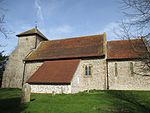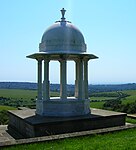Patcham Pylon

The Patcham Pylon is a monumental gateway erected in 1928 near Patcham in East Sussex, England. Designed by local architect John Leopold Denman and paid for by public subscription, it commemorated the extension of the County Borough of Brighton on 1 April 1928, and stood close to the new northern boundary. The gateway consists of two stone towers known locally as "the Pylons", with built-in seats around their bases. They still stand and are clearly visible to travellers on either carriageway of the A23 road to London. They straddle the southbound carriageway of the A23 just inside the city of Brighton and Hove and are individually listed at Grade II along with the benches that were rebuilt in 1992.
Excerpt from the Wikipedia article Patcham Pylon (License: CC BY-SA 3.0, Authors, Images).Patcham Pylon
London Road, Mid Sussex District Pyecombe
Geographical coordinates (GPS) Address Nearby Places Show on map
Geographical coordinates (GPS)
| Latitude | Longitude |
|---|---|
| N 50.88059 ° | E -0.16526 ° |
Address
Wes Pylon
London Road
BN45 7FJ Mid Sussex District, Pyecombe
England, United Kingdom
Open on Google Maps











